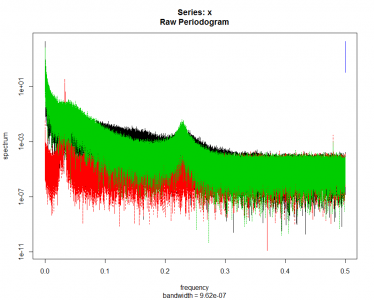Frequency spectrum for the platform
on Monday, December 14th, 2015 2:35 | by Christian Rohrsen
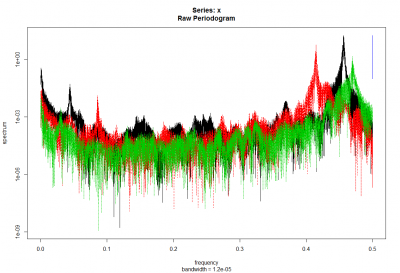 Spectrum with the x axis showing the frequency so that 0.5 is half of the measuring frequency (in this case 20Hz and so it measures until the Nyquist frequency: 10Hz).Here we see the result for the three platforms without any flies. From time to time I hit the table to make some signal in the platforms
Spectrum with the x axis showing the frequency so that 0.5 is half of the measuring frequency (in this case 20Hz and so it measures until the Nyquist frequency: 10Hz).Here we see the result for the three platforms without any flies. From time to time I hit the table to make some signal in the platforms
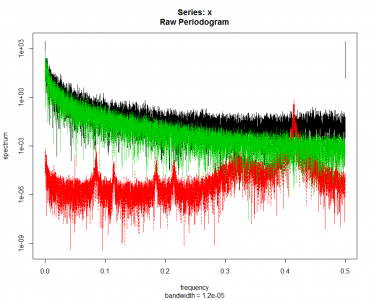 To compare the power of the frequency put together platform with (green and black) and without flies (red).
To compare the power of the frequency put together platform with (green and black) and without flies (red).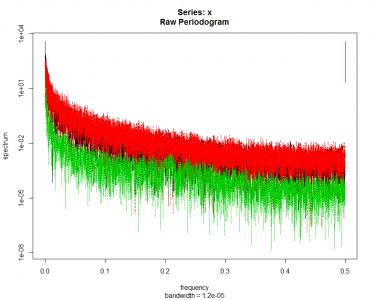 This is the case of three different flies in each platform.
This is the case of three different flies in each platform.
Here the same flies, just in different platforms. There we see that some platforms show stronger signal than other (if I remember well). So is not the fly making the difference. But I have to check. 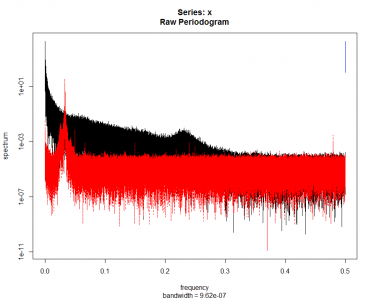 Measuring in this case the 250Hz raw data. In black with a fly and in red without fly
Measuring in this case the 250Hz raw data. In black with a fly and in red without fly
Measuring in this case the 250Hz raw data. This time with and additional fly (green). We can see a characteristic peak at around 60Hz.
Category: R code, Spontaneous Behavior | No Comments
Measuring Wingstroke Amplitude with Strokelitude (IV)
on Monday, December 7th, 2015 2:56 | by Pablo Martinez
After getting good results in the measurement of the wingstroke, and solving problems with the sampling intervals (image below). I have started to measure flies for the experiments.
The time between samples was different depending on the background programs running on the background:
Figure 1
More differences in time within samples when more programs are running at the same time as strokelitude (3nd 1/3 of the plot), when just the display of the camera is running( 1st 1/3 of the plot), and everything shut down(2nd 1/3 of the plot).
The differences among sampling intervals was bigger but with an adjustment of the data, Christian Rohrsen managed to changed. The time between two samples could arise until 1.7 seconds and with the correlation, the time is not bigger than 0.05 seconds.
The strains of flies used fore the experiments are:
UAS-TNT-E, that express the tetanus toxin in the neural cells, using GAL4 system. Being Used as a control.
c105;;c232, that contains a promotor region to express the toxin. Being used as a control.
And the cross between both to have the expression of the tetanus toxin.
Some data from the control flies (UAS-TNT-E):
And some data of the spikes:
Category: flight, Spontaneous Behavior, strokelitude, WingStroke | No Comments
Interpolations and Spike analysis
on Monday, December 7th, 2015 2:42 | by Christian Rohrsen
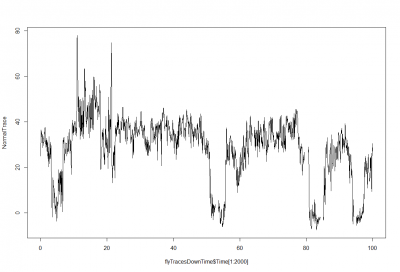
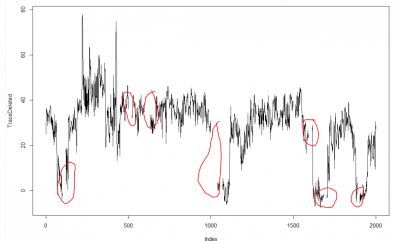
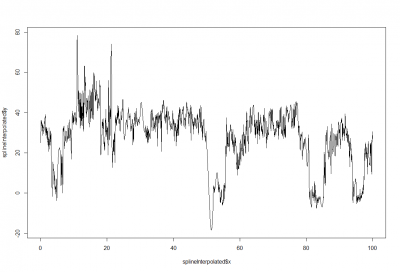 This is just a proof of concept how useful the interpolation is for this purpose: and I would say it´s almost useless. If I delete from the raw data (1st graph) some pieces (2nd graph), and I make a spline interpolation (3rd graph) it doesn´t match that well. Linear interpolation was done in previous weeks with not much of a success. Anyway, the result of a linear interpolation can be imagined by eye just by joinning the two ends with a straight line, and this doesn´t occur in the fly behavior as we can see in the raw data (1st graph).
This is just a proof of concept how useful the interpolation is for this purpose: and I would say it´s almost useless. If I delete from the raw data (1st graph) some pieces (2nd graph), and I make a spline interpolation (3rd graph) it doesn´t match that well. Linear interpolation was done in previous weeks with not much of a success. Anyway, the result of a linear interpolation can be imagined by eye just by joinning the two ends with a straight line, and this doesn´t occur in the fly behavior as we can see in the raw data (1st graph).

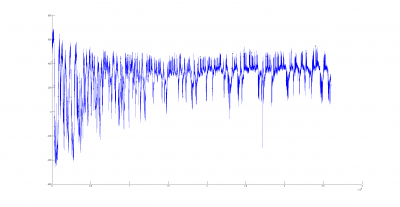
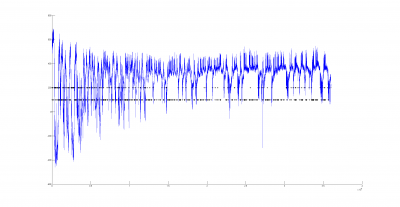
 There could be two posibilities for spike detection: one is the one from Ute and the other one is the one from Maye. It seems to me that the one from Maye is more precise. I have run the script but I do not get so many spike detections as he gets. I did try several thresholds for spike detection and doesn´t change very much. So I have to work more on it to see what is really the important factor for a proper spike detection
There could be two posibilities for spike detection: one is the one from Ute and the other one is the one from Maye. It seems to me that the one from Maye is more precise. I have run the script but I do not get so many spike detections as he gets. I did try several thresholds for spike detection and doesn´t change very much. So I have to work more on it to see what is really the important factor for a proper spike detection
Category: flight, R code, Spontaneous Behavior, strokelitude, WingStroke | No Comments
Measuring Wingstroke Amplitude with Strokelitude (III)
on Monday, November 23rd, 2015 2:59 | by Pablo Martinez
After the measurements of this week, I get better results in the trace of the fly;
(1)
With the corresponding trace exerpt with the spikes of the figure above (1)
(1)
and two more from other flies:
Category: Spontaneous Behavior, strokelitude, WingStroke | No Comments
Measuring Wingstroke Amplitude with Strokelitude (II)
on Monday, November 16th, 2015 2:52 | by Pablo Martinez
After the results in tracing of the flies from last wee. This week I’ve improved detection of the wings and the care of the flies. The results seem similar to the flight of a fly. Attached we find the trace Downsampled of the best four flies I got:
Category: Spontaneous Behavior, strokelitude, WingStroke | No Comments
Linear interpolation for solving uneven sampling in the platform
on Monday, November 16th, 2015 2:50 | by Christian Rohrsen
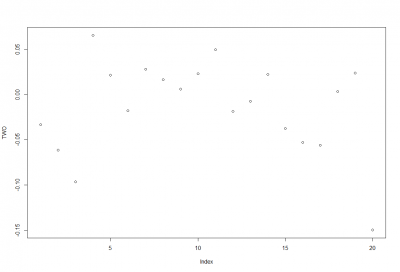 This is the prediction of one of the controls (UAS-TNTxWTB) after being interpolated for compensating for the uneven sampling. The y-axis is Correlation coeficient (taking correlation of bins of 100 sampled points) for the next 2000 sampled points (x-axis). There seems to be no decay in the prediction, as if it was a random behavior. Aparently linear interpolation is not suited for this case. I have heard that linear interpolation is fine when sampling rate variation is low (like 5%). For this case, spline interpolation might be better. If this is really worth to do I don´t know, the best case would be for sure to have the hardware to sample according to the necessities.
This is the prediction of one of the controls (UAS-TNTxWTB) after being interpolated for compensating for the uneven sampling. The y-axis is Correlation coeficient (taking correlation of bins of 100 sampled points) for the next 2000 sampled points (x-axis). There seems to be no decay in the prediction, as if it was a random behavior. Aparently linear interpolation is not suited for this case. I have heard that linear interpolation is fine when sampling rate variation is low (like 5%). For this case, spline interpolation might be better. If this is really worth to do I don´t know, the best case would be for sure to have the hardware to sample according to the necessities.
Category: R code, Spontaneous Behavior | No Comments
Spontaneity: Measuring Wingstroke Amplitude with Strokelitude
on Monday, November 9th, 2015 3:38 | by Pablo Martinez
Those are the results of measuring the wingstroke amplitude with Strokelitude and “The ping pong ball machine”. And analysed with R studio and the scripts written by an student.
The results are not too good, comparing them with the result obtained in other experiments.
Two pictures of the trace down-sampled of my flies:
and in the next picture is how it should be plotted:
Category: Spontaneous Behavior, strokelitude, WingStroke | No Comments
Sampling rate in the platform: looking for even sampling times
on Monday, September 28th, 2015 2:28 | by Christian Rohrsen
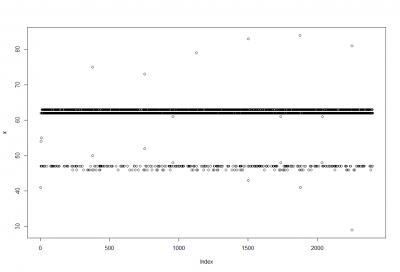
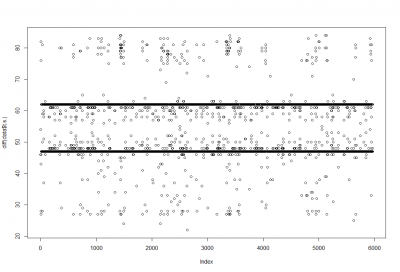 Homogeneity of the sampling rate in the platform: is improved mainly by stopping any other running programs and the internet, setting priority in the CPU doesn´t improve much. This doesn´t completely solve the problem so the priority was also changed in the code of the software itself and the sampling frequency has been changed to a higher one (because this one isn´t enough for intrapolation from what I have seen) in order to be able to make intrapolation. However we will try to change this to around 62ms sampling because the system somehow tends to measure a this time. In addition I did model several behaviors (white noise random, oscilatory activity with three frequencies, and several chaotic systems: logistic, clifford and lorentz) to see what their parameters and graphs look like, but they all have very incongruent results, so it didn´t bring much info. I have to check if I´m setting the right values for the analysis parameters.
Homogeneity of the sampling rate in the platform: is improved mainly by stopping any other running programs and the internet, setting priority in the CPU doesn´t improve much. This doesn´t completely solve the problem so the priority was also changed in the code of the software itself and the sampling frequency has been changed to a higher one (because this one isn´t enough for intrapolation from what I have seen) in order to be able to make intrapolation. However we will try to change this to around 62ms sampling because the system somehow tends to measure a this time. In addition I did model several behaviors (white noise random, oscilatory activity with three frequencies, and several chaotic systems: logistic, clifford and lorentz) to see what their parameters and graphs look like, but they all have very incongruent results, so it didn´t bring much info. I have to check if I´m setting the right values for the analysis parameters.
Category: R code, Spontaneous Behavior | No Comments
Analysis for spontaneity in platform
on Monday, September 21st, 2015 2:26 | by Christian Rohrsen
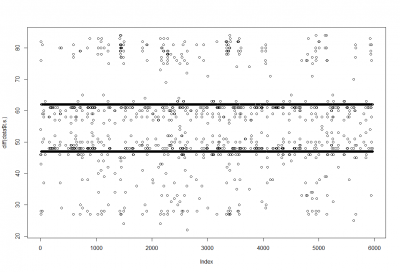
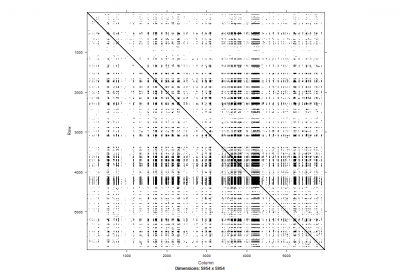 The sampling rate is not homogeneous and this affect a lot the processing of the data for non linearity. What can be done? On the right we see a recurrent plot of one single fly in darkness for 5 min. It seems to be to some extent periodic, not much chaotic (but I need more experience to really guess that) For more information https://www.recurrence-plot.tk/rqa.php.
The sampling rate is not homogeneous and this affect a lot the processing of the data for non linearity. What can be done? On the right we see a recurrent plot of one single fly in darkness for 5 min. It seems to be to some extent periodic, not much chaotic (but I need more experience to really guess that) For more information https://www.recurrence-plot.tk/rqa.php.
In the table below we see a low recurrence but high determinism among many other parameters.
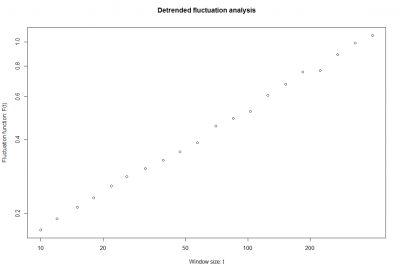 The E2 line shows values around 1 the whole time when the sample is random. This is contradicting the above. The detrended fluctuation analysis show a value around 0.5, which means that if these data was modelled as random it would look like white noise.
The E2 line shows values around 1 the whole time when the sample is random. This is contradicting the above. The detrended fluctuation analysis show a value around 0.5, which means that if these data was modelled as random it would look like white noise.
Category: R code, Spontaneous Behavior | No Comments
publishing torque meters comparison
on Wednesday, March 6th, 2013 11:17 | by Julien Colomb
here is the draft: https://figshare.com/preview/_preview/644625
Is there any good publication describing the wing beat analyser?
other remarks?
Category: flight, open science, Spontaneous Behavior, writing/publishing | No Comments
